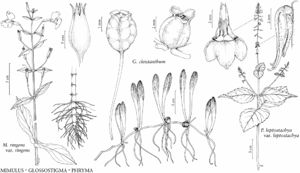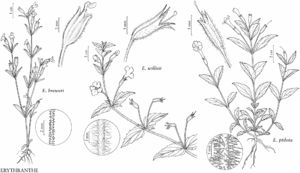Difference between revisions of "Phrymaceae"
FNA>Volume Importer |
imported>Volume Importer |
||
| (5 intermediate revisions by 2 users not shown) | |||
| Line 95: | Line 95: | ||
-->{{#Taxon: | -->{{#Taxon: | ||
name=Phrymaceae | name=Phrymaceae | ||
| − | |author=Richard K. Rabeler; Craig C. Freeman; Wayne J. Elisens | + | |author=Richard K. Rabeler;Craig C. Freeman;Wayne J. Elisens |
|authority=Schauer | |authority=Schauer | ||
|rank=family | |rank=family | ||
| Line 102: | Line 102: | ||
|basionyms= | |basionyms= | ||
|family=Phrymaceae | |family=Phrymaceae | ||
| + | |illustrator=Yevonn Wilson-Ramsey | ||
| + | |illustration copyright=Flora of North America Association | ||
|distribution=North America;Mexico;Central America;w South America (primarily Andean);s Asia (India);se Asia;e Africa;Indian Ocean Islands (Madagascar);Pacific Islands (New Zealand);Australia;introduced in Europe;s Africa. | |distribution=North America;Mexico;Central America;w South America (primarily Andean);s Asia (India);se Asia;e Africa;Indian Ocean Islands (Madagascar);Pacific Islands (New Zealand);Australia;introduced in Europe;s Africa. | ||
|reference=barker2012a;beardsley2002a;cantino2004a;fischer2004a | |reference=barker2012a;beardsley2002a;cantino2004a;fischer2004a | ||
| Line 107: | Line 109: | ||
|publication year= | |publication year= | ||
|special status= | |special status= | ||
| − | |source xml=https:// | + | |source xml=https://bitbucket.org/aafc-mbb/fna-data-curation/src/2e0870ddd59836b60bcf96646a41e87ea5a5943a/coarse_grained_fna_xml/V17/V17_1261.xml |
}}<!-- | }}<!-- | ||
-->[[Category:Treatment]] | -->[[Category:Treatment]] | ||
Latest revision as of 19:27, 5 November 2020
Herbs, subshrubs, or shrubs, annual or perennial, aquatic or terrestrial, sometimes fleshy, autotrophic. Stems erect or ascending to prostrate, 4-angled, sometimes winged. Leaves deciduous or persistent, basal and cauline or all cauline, rarely subrosulate or rosulate (Erythranthe), opposite, or alternate distally, simple; stipules absent; petiole present or absent; blade fleshy, semi-fleshy, or not, not leathery, margins entire or toothed. Inflorescences terminal and axillary racemes or flowers solitary (Glossostigma, some Erythranthe, some annual plants); flowers erect to nodding or strongly reflexed and appressed to inflorescence axis (Phryma). Flowers bisexual, perianth and androecium hypogynous; sepals (3 or)4 or 5, proximally connate, calyx radially or bilaterally symmetric; petals 3–5, proximally connate, corolla bilaterally symmetric, rarely nearly radially in reduced forms, strongly to weakly bilabiate, rarely nearly regular, salverform to tubular-funnelform, funnelform, campanulate, or compressed; stamens (2–)4, adnate to corolla, didynamous [both pairs of equal length in autogamous forms], staminode 0; pistil 1, 2-carpellate, ovary superior, (1 or)2-locular, placentation axile, basal (Phryma), or parietal (Diplacus, Mimetanthe); ovules anatropous or orthotropous (Phryma), unitegmic, tenuinucellate; style 1; stigma 1, 2-lobed. Fruits capsules, dehiscence loculicidal [septicidal or irregular], or achenes [berry]. Seeds 1–2000, yellowish brown or brown, narrowly ellipsoid, slightly flattened bilaterally; embryo straight, endosperm sparse.
Distribution
North America, Mexico, Central America, w South America (primarily Andean), s Asia (India), se Asia, e Africa, Indian Ocean Islands (Madagascar), Pacific Islands (New Zealand), Australia, introduced in Europe, s Africa.
Discussion
Genera 13, species ca. 200 (6 genera, 139 species in the flora).
Over one half of the species in Phrymaceae are members of Diplacus and Erythranthe and together include over 160 species; all other genera each have seven or fewer species.
Until recently, Phrymaceae consisted only of Phryma leptostachya, a taxonomically isolated species of eastern North America and eastern Asia. Molecular studies have established a relationship not with the Verbenaceae, as was earlier postulated (see H. L. Whipple 1972; R. Venkata Ramana et al. 2000), but rather with Mimulus and other genera, suggesting that Phrymaceae should be enlarged. The sequence of genera in Phrymaceae here follows the phylogeny proposed by P. M. Beardsley and R. G. Olmstead (2002).
One of the major lineages of Phrymaceae is primarily a Southern Hemisphere group ranging from Australia and New Zealand to southeastern and south Asia (India), Madagascar, and South Africa. Mimulus in the narrow sense, including the two endemic North American species, is part of this group, which includes 24 species in seven genera. The largest major lineage includes 158 species in five genera from North America, South America, and southeast Asia. This lineage includes two genera from Mexico and Central America: Hemichaena Bentham, which is sister to the North American Diplacus and Mimetanthe, and Leucocarpus D. Don, which is sister to the American and Asian Erythranthe.
Selected References
Lower Taxa
Illustrations
Key
| 1 | Plants aquatic or semi-aquatic, mat-forming. | > 2 |
| 2 | Stems functionally stolons, leaves on stolons; sepals 3; leaf blades fleshy. | Glossostigma |
| 2 | Stems prostrate to decumbent or erect; sepals 5, sometimes 3 in reduced forms; leaf blades sometimes thickened or semi-fleshy. | Erythranthe |
| 1 | Plants terrestrial or, if semi-aquatic, not mat-forming. | > 3 |
| 3 | Flowers strongly reflexed and appressed to inflorescence axes in fruit; fruits achenes; bracteoles present. | Phryma |
| 3 | Flowers lateral or erect to nodding, not strongly reflexed and appressed in fruit; fruits capsules; bracteoles absent. | > 4 |
| 4 | Fruit apices rounded to truncate; placentation axile. | > 5 |
| 5 | Leaf venation brochidodromous; stamens adnate to middle of corolla. | Mimulus |
| 5 | Leaf venation acrodromous (veins usually basal only, sometimes basal and suprabasal); stamens adnate proximal to middle of corolla. | Erythranthe |
| 4 | Fruit apices attenuate; placentation parietal. | > 6 |
| 6 | Pedicels ± equal to or slightly longer than calyces; calyx lobe midveins low-rounded, not wing-angled; fruit walls densely pustulate-glandular. | Mimetanthe |
| 6 | Pedicels nearly absent or shorter than calyces, rarely ± equal to or slightly longer than calyces; calyx lobe midveins angled or wing-angled; fruit walls smooth, eglandular. | Diplacus |


